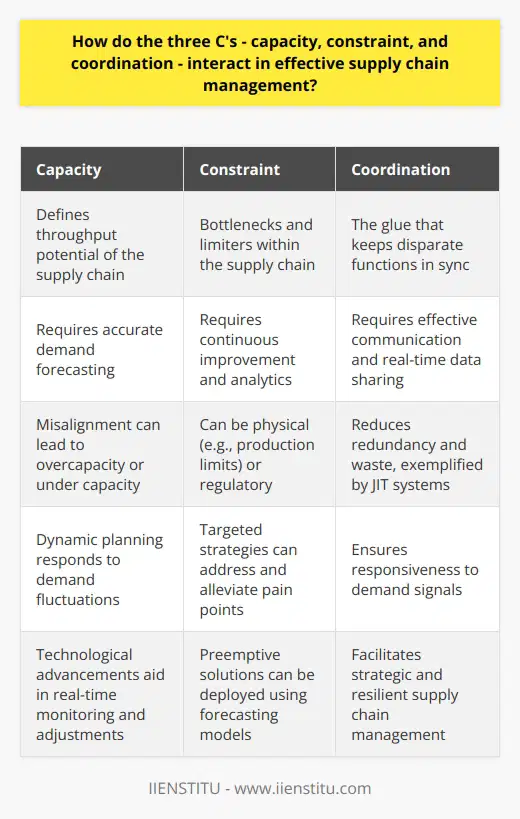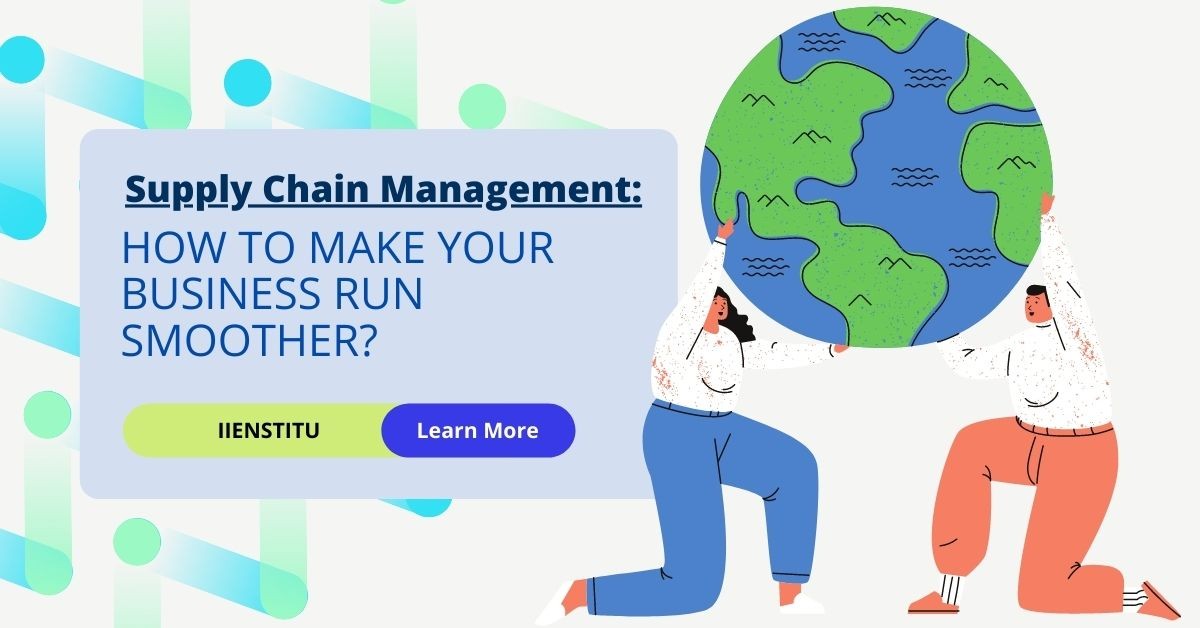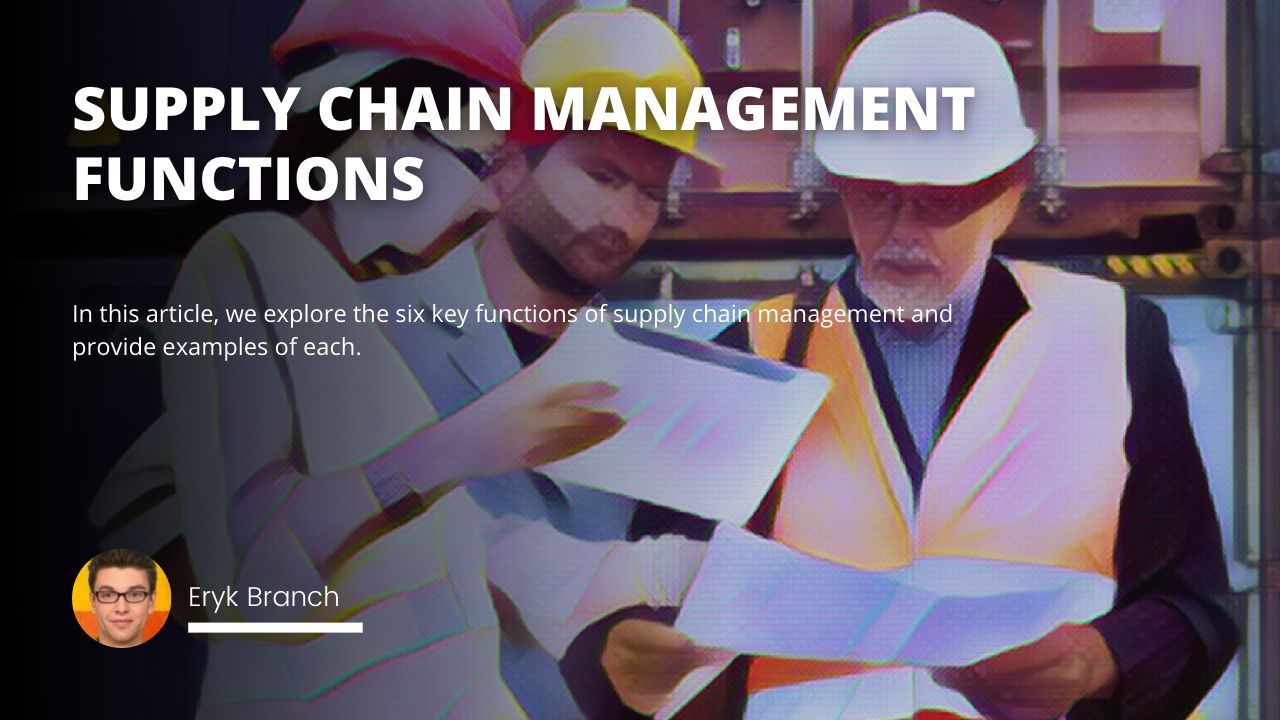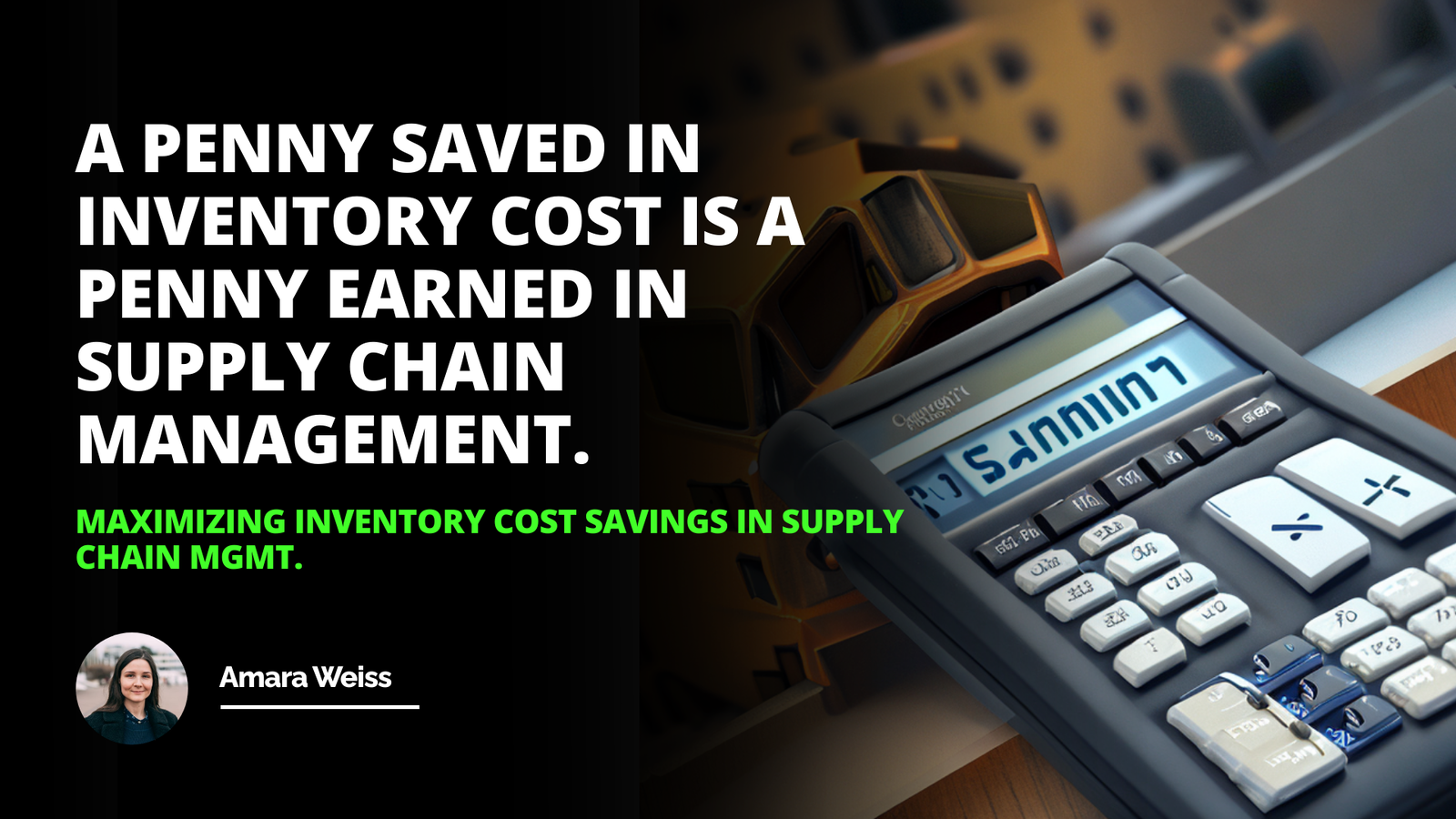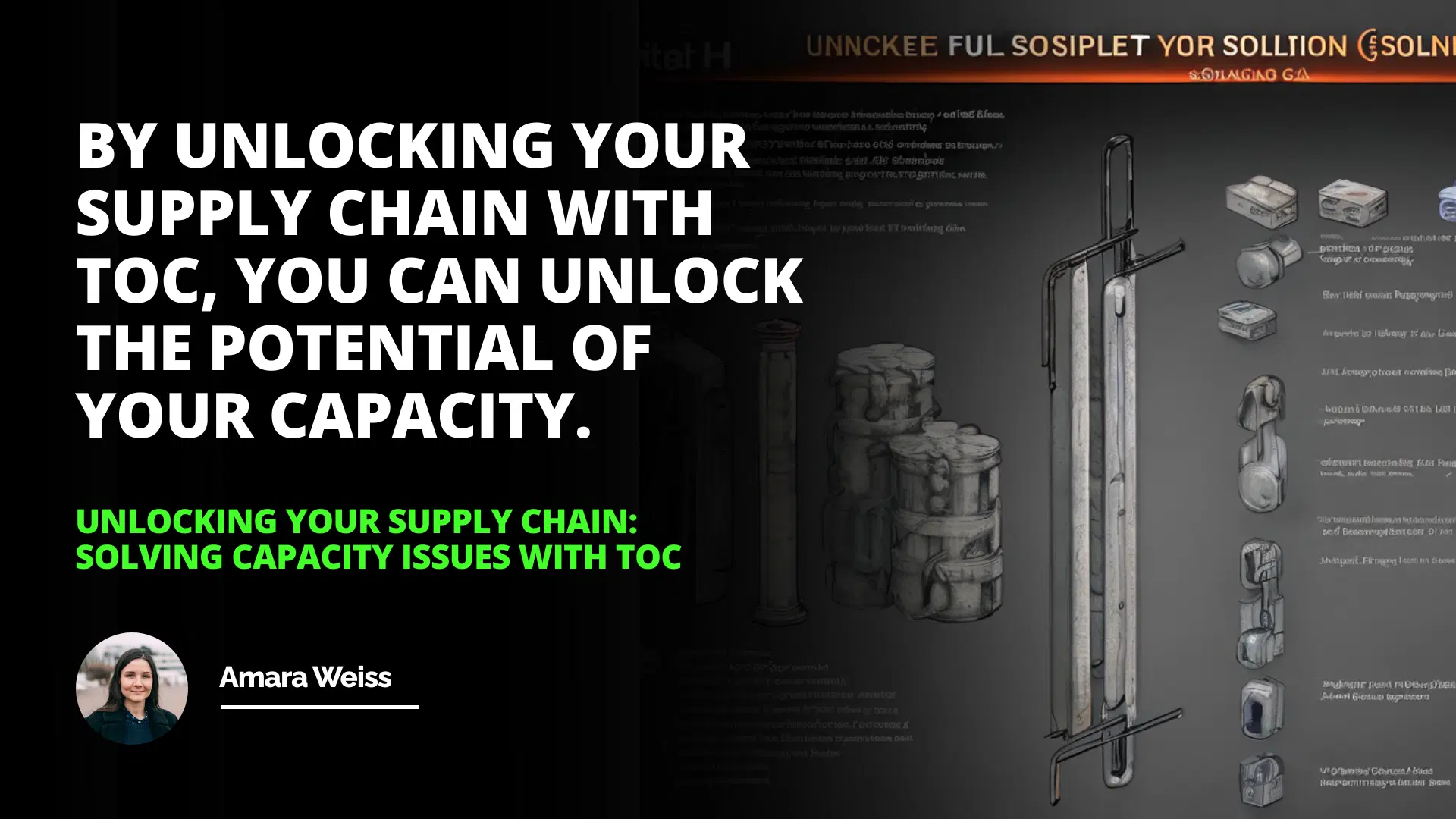
I still remember the day when I was first introduced to the Theory of Constraints (TOC) in a supply chain management seminar. The concept was both enlightening and transformative. It dawned on me that much like the weakest link in a chain determines its overall strength, a single bottleneck can limit the entire capacity of a supply chain. This realization sparked a newfound passion for optimizing supply chain processes, and I became eager to delve deeper into how TOC could unlock unprecedented efficiencies.
In the fast-paced world of supply chain management, meeting customer demands swiftly and efficiently is paramount. However, various constraints often impede this goal, leading to delays and dissatisfied customers. Supply chain management management isn't just about moving goods from point A to point B; it's about ensuring every part of the process is optimized and functioning harmoniously.
Introduction
Identifying the Constraint
Option 1: Slowing Down the Process
Option 2: Improving the Constraint
Conclusion
In this article, we'll explore the Theory of Constraints in detail, guiding you through the process of identifying bottlenecks in your supply chain activities and discussing two primary strategies to enhance capacity. Whether you're a seasoned professional or new to SCM management, these insights can help you revolutionize your approach to supply chain mgmt.
Understanding the Theory of Constraints in Supply Chain Management
At its core, the Theory of Constraints is a methodology for identifying the most significant limiting factor (i.e., the constraint) in a process and systematically improving it. As Dr. Eliyahu M. Goldratt, the father of TOC, once said, "Tell me how you measure me, and I'll tell you how I will behave." This quote underscores the importance of recognizing and measuring constraints to drive behavioral change and process improvement.
The Essence of Constraints
In the realm of supply and chain management, a constraint could be any element that prevents the system from achieving higher performance. These constraints can be internal, such as a machine's production capacity, or external, like market demand fluctuations. Identifying and addressing these constraints is crucial for optimizing the entire supply chain m.
Personal Encounter with Constraints
In my early days as a supply chain analyst, I encountered a significant constraint while working for a manufacturing company. Despite high demand, we couldn't increase our output. After some investigation, we discovered that a specific component supplied by a vendor had a long lead time, creating a bottleneck. This experience highlighted the importance of chain of supply management and the need to identify and address constraints promptly.
Identifying the Constraint: The First Step Toward Optimization
The journey to optimize your supply chain begins with pinpointing the constraint. Here's how you can effectively identify it:
1- Data Collection and Analysis: Gather data on all processes within your supply chain. Look for areas where delays occur or where throughput is consistently lower than other areas.
2- Process Mapping: Create a visual representation of your supply chain activities. This map helps in identifying stages that slow down the overall process.
By unlocking your supply chain with TOC, you can open the potential of your capacity.
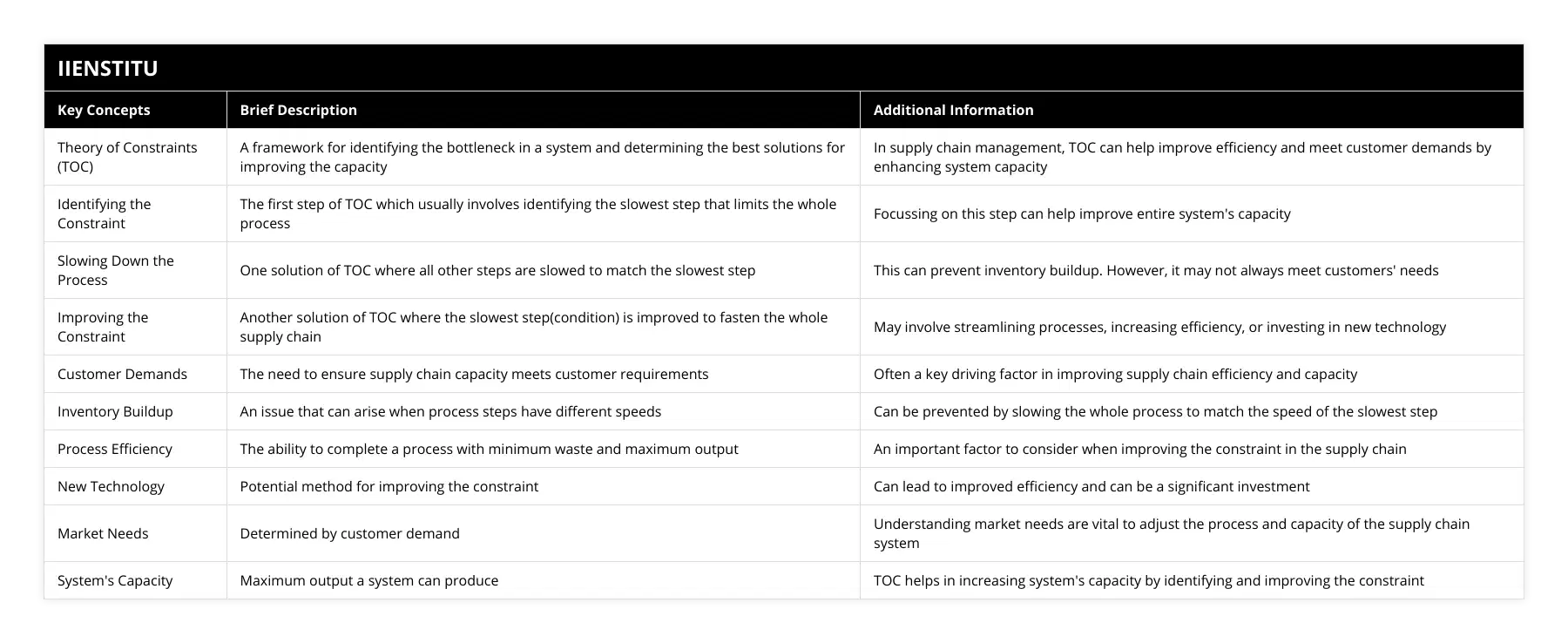
3- Employee Feedback: Those working on the front lines often have valuable insights. Engage with your team to understand where they perceive bottlenecks.
4- Performance Metrics: Establish key performance indicators (KPIs) for each stage of the supply chain mgmt to identify underperforming segments.
5- Benchmarking: Compare your processes against industry standards to spot areas needing improvement.
Underlined: Identifying the constraint is not a one-time task but a continuous process crucial for sustained efficiency.
Option 1: Slowing Down the Process
Once the constraint is identified, one potential solution is to adjust the pace of other processes to match the constraint's capacity.
The Logic Behind Slowing Down
At first glance, slowing down might seem counterproductive. However, aligning all processes prevents excess inventory buildup and reduces wasted resources. This method ensures that the constraint is not overburdened, which could lead to breakdowns or quality issues.
Pros and Cons of Slowing Down
Pros:
Inventory Control: Reduces surplus stock and associated holding costs.
Resource Allocation: Optimizes the use of resources across the supply chain.
Process Stability: Creates a steady workflow, making it easier to manage.
Cons:
Reduced Output: Overall production might decrease, affecting revenue.
Customer Satisfaction: Delays in order fulfillment could impact customer relationships.
Competitive Disadvantage: Slower processes might allow competitors to capture market share.
Italicized: In my experience, slowing down is a short-term fix. While it stabilizes processes, it doesn't address the root cause of the constraint.
Case Study: A Real-world Application
At a previous company, we faced a constraint in the packaging department. To prevent overproduction and wasted materials, we slowed down the assembly line. This adjustment led to reduced overtime costs but also delayed shipments, resulting in customer complaints. The lesson learned was that while slowing down can offer temporary relief, it's not a sustainable long-term strategy.
Option 2: Improving the Constraint
The second, and often more effective, option is to enhance the performance of the constraint itself.
Strategies for Improvement
1- Process Improvement Techniques: Implement methodologies like Lean or Six Sigma to streamline operations.
2- Technological Upgrades: Invest in modern equipment or software that increases efficiency.
3- Training and Development: Equip employees with the skills needed to improve productivity.
4- Additional Resources: Allocate more staff or shifts to the constrained area.
5- Supplier Collaboration: Work closely with suppliers to reduce lead times and improve quality.
Bold: Focusing on the constraint transforms it from a bottleneck into a catalyst for growth.
Benefits of Improving the Constraint
Increased Throughput: Enhances overall production capacity.
Customer Satisfaction: Faster fulfillment times improve customer experiences.
Competitive Edge: Ability to meet market demands swiftly can set you apart from competitors.
Revenue Growth: Higher output often leads to increased sales and profitability.
My Success Story with Constraint Improvement
In one of my most rewarding projects, we faced a constraint in our machining process. By investing in a new CNC machine and providing specialized training to operators, we increased that station's capacity by 50%. This improvement not only eliminated delays but also opened opportunities for new contracts, significantly boosting the company's bottom line.
Combining Both Options for Optimal Results
Sometimes, the best approach is a hybrid one. While working on improving the constraint, it's practical to adjust other processes to maintain balance.
The Balanced Approach
Short-term Adjustments: Temporarily slow down non-critical processes to prevent overwhelming the constraint.
Long-term Investments: Simultaneously work on strategies to enhance the constraint's capacity.
Continuous Monitoring: Regularly assess the supply chain to identify new constraints as they emerge.
Bold and Underlined: This balanced strategy ensures immediate stability and paves the way for sustained improvements.
Factors Influencing the Choice of Option
Several variables determine whether you should slow down processes or focus on improving the constraint:
Resource Availability: Do you have the capital and human resources to invest in improvements?
Time Constraints: Is there an urgent need to meet market demand?
Market Conditions: Are competitors likely to capitalize on any slowdown in your operations?
Strategic Goals: Does improving the constraint align with your long-term business objectives?
Italicized: It's essential to consider these factors holistically to make an informed decision.
The Ongoing Cycle of Improvement
Remember that once a constraint is resolved, another will take its place. This concept is known as the "continuous improvement loop" in supply chain management.
Steps in the Continuous Improvement Loop
1- Identify: Locate the current constraint.
2- Exploit: Make quick improvements to optimize the constraint.
3- Subordinate: Align other processes to support the constraint's maximum capacity.
4- Elevate: Invest in significant changes to eliminate the constraint.
5- Repeat: Once the constraint is broken, return to step one.
Bold: This cycle ensures that your supply chain m evolves and improves continuously.
Embracing Technology and Innovation
The future of SCM supply lies in leveraging technology. Tools like AI and IoT can provide real-time data, helping identify and address constraints more efficiently.
Technological Solutions
Predictive Analytics: Anticipate potential constraints before they become critical.
Automation: Use robotics and automated systems to increase capacity.
Cloud Computing: Enhance collaboration and data accessibility across the supply chain.
Final Thoughts
Optimizing your supply chain management process tips isn't just about immediate fixes; it's about fostering a culture of continuous improvement. By understanding and applying the Theory of Constraints, you position your organization to respond adeptly to challenges and seize new opportunities.
Bold: In the dynamic world of supply chain mgmt, adaptability and proactive improvement are your greatest assets.
Encouraging Empowerment and Collaboration
Empower your team to identify constraints and propose solutions. Collaboration across departments can uncover insights that might otherwise be overlooked.
Italicized and Underlined: After all, a unified team can overcome any obstacle.
References
1- Goldratt, E. M. (1984). The Goal: A Process of Ongoing Improvement. North River Press.
2- Schragenheim, E., Dettmer, H. W., & Patterson, J. (2009). Supply Chain Management at Warp Speed: Integrating the System from End to End. CRC Press.
3- Mentzer, J. T. (2004). Fundamentals of Supply Chain Management: Twelve Drivers of Competitive Advantage. Sage Publications.
4- Krajewski, L. J., Ritzman, L. P., & Malhotra, M. K. (2013). Operations Management: Processes and Supply Chains. Pearson Education.
5- Chopra, S., & Meindl, P. (2010). Supply Chain Management: Strategy, Planning, and Operation. Prentice Hall.
By embracing the Theory of Constraints and continually seeking to improve, you'll not only enhance your supply chain activities but also drive your organization toward greater success. Remember, in the ever-evolving landscape of supply chain management, staying stagnant is not an option. So take the first step, identify that constraint, and unlock your supply chain's full potential.
Frequently Asked Questions
What is the Theory of Constraints (TOC) and how can it be used to unlock supply chain capacity issues?
The Theory of Constraints (TOC) is a management framework used to identify, analyze and resolve constraints in a given system. Dr. Eliyahu M. Goldratt introduced it in his 1984 book The Goal. The goal of the TOC is to maximize throughput in a system while minimizing the resources used to do so. As a result, it has become increasingly popular in the business world, particularly in supply chain management.
TOC is based on three basic principles: identify the constraint, exploit the control, and subordinate everything to the rule. It is designed to identify and eliminate existing conditions or inefficiencies in a system, allowing it to operate more efficiently and effectively.
The application of TOC in supply chain management is typically used to unlock supply chain capacity issues. The TOC approach identifies the bottleneck or constraint in the system, which is the element that limits the system's throughput. Once the condition has been identified, efforts can be made to exploit it or make the most of it to improve overall system performance. This can include increasing throughput, reducing demand, or reducing lead times.
In addition, TOC can be used to identify and eliminate the waste associated with the system. Waste is any activity that does not add value, including excess inventory, delays in the production process, or inefficient resource utilization. By eliminating waste, the system can be made more efficient and productive.
In summary, the Theory of Constraints is a powerful management tool that can unlock supply chain capacity issues. It can identify and eliminate bottlenecks and waste while maximizing throughput and resource utilization. By applying the TOC approach, organizations can ensure that their supply chain runs as efficiently and effectively as possible.
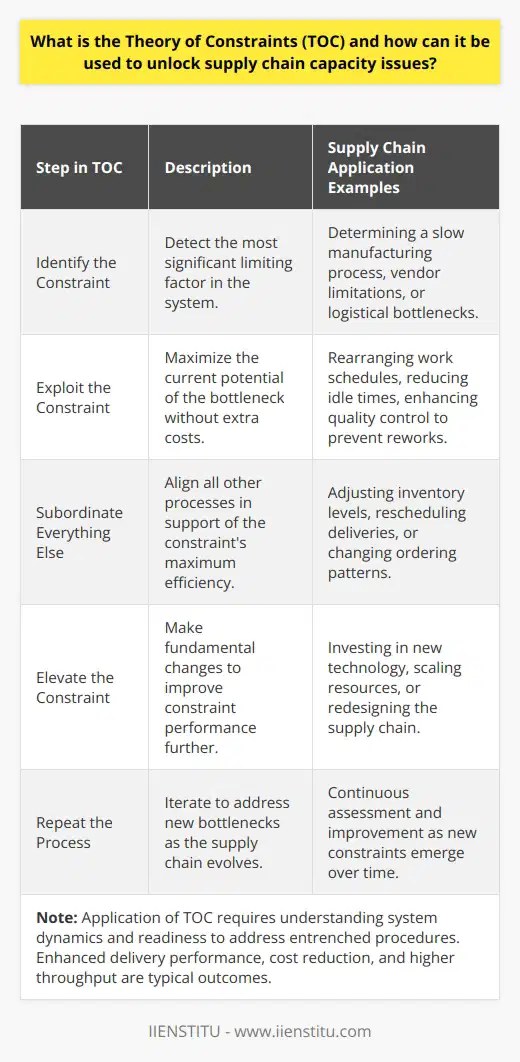
What are the two main options for solving capacity issues with TOC?
Capacity issues with the Theory of Constraints (TOC) can be solved in two main ways: exploiting the constraint and subordinating everything else to the rule. This article will discuss each option in depth to provide an overview of the capacity issues and their solutions.
The Theory of Constraints (TOC) is an approach that is used to manage resources within an organization and maximize throughput. The basic premise of TOC is that there is always a bottleneck, or constraint, in a process that limits the organization's overall capacity. If the blockage is not addressed, the organization will not be able to achieve its full potential.
The first option for solving capacity issues with TOC is to exploit the constraint. This involves ensuring that the condition is utilized efficiently and effectively. For example, this might include increasing the constraint's capacity, improving the quality of the inputs to the rule, or adjusting the process to ensure that the condition is being used to its fullest potential. This approach can be beneficial in the short term, but it is not always the best option in the long run.
The second option for solving capacity issues with TOC is to subordinate everything else to the constraint. This involves focusing resources on the condition and ensuring all other activities are aligned. This approach consists of understanding the impact of different activities on the state and adjusting them accordingly. This can help ensure that the conditions are being used to their fullest potential and that the organization is making the most of its resources.
In conclusion, capacity issues with TOC can be solved in two main ways: exploiting the constraint and subordinating everything else to the rule. It is essential to understand the condition's impact on the organization and adjust resources accordingly to maximize throughput. By doing this, organizations can make the most of their resources and achieve their full potential.

How can TOC be used to identify the constraint in a supply chain?
The Theory of Constraints (TOC) is a widely used management method that aims to maximize the performance of a system by identifying and removing its constraints. For example, the TOC can determine the rule limiting the entire system's performance in supply chain management.
The first step in using the TOC to identify the constraint in a supply chain is to identify the critical resources needed for the system to operate. These vital resources can include physical resources such as raw materials, personnel, and space, as well as intangible resources such as information and knowledge. Once the essential resources have been identified, the TOC methodology can be applied to analyze the flow of these resources and identify any bottlenecks or constraints limiting the system's performance.
The analysis of the flow of resources can be done through various methods, such as process mapping or simulation software. Process mapping involves creating a visual representation of the flow of resources through the supply chain, which can then be used to identify any potential bottlenecks. Simulation software can model the flow of resources and identify any possible constraints.
Once the potential constraints have been identified, the TOC methodology can be used to determine the best course of action to remove the restriction and maximize the performance of the system. This can involve identifying alternative resources that can be used to increase the flow of resources and reduce the bottleneck or introducing changes to the workflow that can reduce the impact of the constraint.
The TOC can be an effective tool for supply chain management, as it allows managers to identify the constraints limiting the system's performance and remove them. By eliminating the rules, managers can ensure that the supply chain runs at maximum efficiency and performance.

What are the key principles of the Theory of Constraints (TOC) in supply chain management?
Key Principles of TOC in Supply Chain Management
Identifying Constraints
One of the fundamental principles of the Theory of Constraints (TOC) in supply chain management is identifying the constraints or bottlenecks that limit the system's overall performance. By recognizing these restrictions, organizations can focus their efforts on improving the weakest link in the supply chain.
Exploiting Constraints
After identifying the constraints, the second principle of TOC is to exploit them fully by optimizing the resources and processes. This step involves maximizing the throughput at the constraint, ensuring its capacity is utilized to the fullest extent possible.
Subordinating Other Processes
To further optimize the supply chain, TOC advocates for the subordination of other processes to the constraint. This means that non-constraint operations must adjust their schedules and capacities to support the bottleneck, ensuring a smooth flow of materials and products.
Elevating Constraints
Once the constraints have been exploited and other processes are subordinated, the next principle of TOC is to elevate the constraint. This involves investing in additional resources or capabilities to alleviate the bottleneck and increase the supply chain's overall performance.
Continuous Improvement
Lastly, TOC encourages a continuous improvement mindset within the organization. As constraints are elevated and new bottlenecks emerge, supply chain managers must adapt and focus on the next constraint to further optimize the system.
In summary, the key principles of the Theory of Constraints in supply chain management are identifying constraints, exploiting them, subordinating other processes, elevating constraints, and fostering a continuous improvement culture. By focusing on these principles, organizations can efficiently optimize their supply chains and improve overall performance.
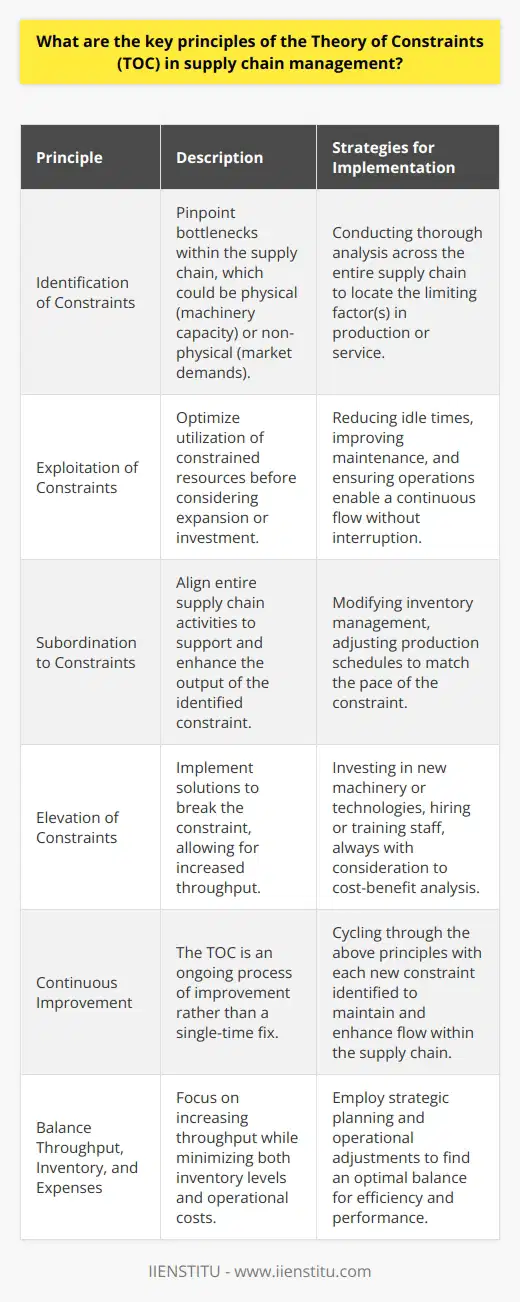
In what ways can TOC contribute to supply chain resilience and sustainability?
Enhancing Supply Chain Resilience
The Theory of Constraints (TOC) can significantly contribute to improving supply chain resilience by identifying and alleviating bottlenecks, enhancing response times and adaptability to disruptions. Utilizing TOC's core steps, such as identifying the weakest link, exploiting it, and elevating it, firms can make better decisions to create robust supply chain strategies that can withstand potential risks and uncertainties effectively.
Optimizing Resource Allocation
In addressing sustainability, TOC can optimize overall resource allocation by identifying and focusing on a single constraint, resulting in minimized waste and improved efficiency. The reduction of excess inventory, energy consumption, and environmental impacts are among the benefits of addressing these constraints. By continuously refining the focus on the constraint, TOC is crucial in driving better performance towards sustainability goals while maintaining profitability for organizations.
Facilitating Supplier Collaboration
One way in which TOC aids supply chain resilience and sustainability is by fostering collaboration among supply chain partners. By identifying common constraints that impact multiple partners, TOC can help facilitate teamwork to eliminate these bottlenecks and create mutually beneficial solutions. Such collaborations can lead to joint planning ventures, shared resources, and synchronized decision-making, contributing to overall supply chain performance and environmental sustainability.
Improving Forecasting and Planning
Furthermore, the TOC's systematic approach to problem-solving can aid supply chain resilience by improving the accuracy of demand forecasting and overall planning efforts. By focusing on the constraint that limits throughput and considering its implications across the chain, decision-makers can gain a deeper understanding of the factors that drive demand fluctuations and supply vulnerabilities. This knowledge can then be used to develop more reliable forecasting models and robust contingency plans, ensuring a better response to potential disruptions in supply.
Strengthening Risk Management
Lastly, the TOC's emphasis on addressing constraints can also contribute to strengthening risk management strategies. By highlighting the vulnerabilities inherent in the constraint, decision-makers can better assess the probability and impact of potential supply chain disruptions. This can guide the development of risk mitigation strategies and proactive recovery measures that minimize the effects of disruptions, whether from natural disasters or market shifts, bolstering the resilience of the supply chain.
In conclusion, the Theory of Constraints offers immense potential to enhance supply chain resilience and sustainability. It does so by identifying bottleneck areas, enabling optimized resource allocation, fostering collaboration, improving demand forecasting and planning, and bolstering risk management strategies. Implementing TOC can lead to a well-prepared and adaptable supply chain capable of withstanding external pressures and supporting long-term organizational success.
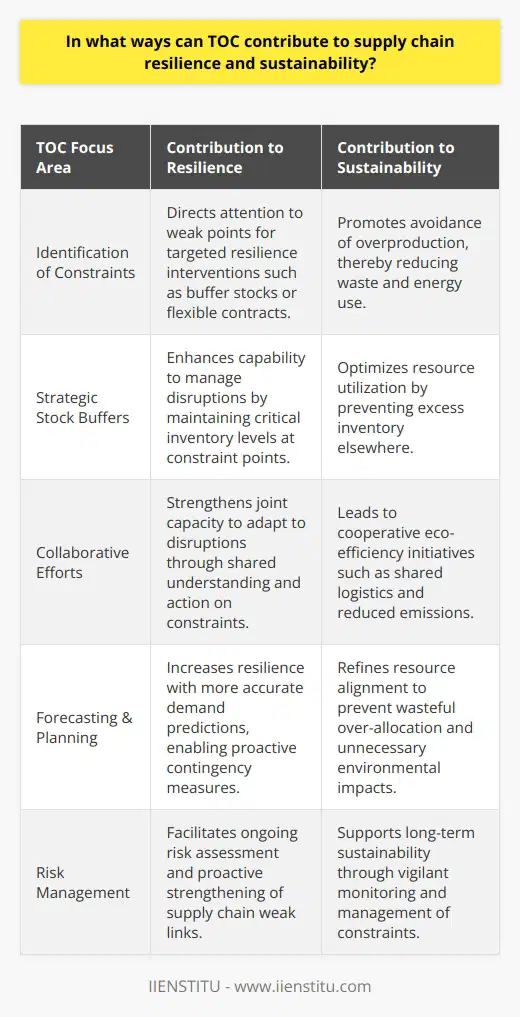
How do the three C's - capacity, constraint, and coordination - interact in effective supply chain management?
Interaction of Capacity, Constraint, and Coordination
Effective supply chain management relies on a balanced interaction between the three C's - capacity, constraint, and coordination. Capacity refers to the ability of the supply chain to handle the volume of goods or services that must move through it. Constraints are factors that limit the optimal functionality of the supply chain. Lastly, coordination involves the harmonization of activities and information flow between supply chain partners.
Balancing Capacity and Constraints
To achieve an efficient supply chain, managers must balance the capacity with the constraints encountered. This ensures that the supply chain can accommodate the necessary volume while minimizing bottlenecks and inefficiencies. Identifying constraints helps managers allocate resources effectively to improve the overall capacity of the supply chain. This balance leads to cost savings, reduced cycle times, and enhanced service quality.
Mitigating Supply Chain Constraints
Identifying constraints is essential to optimize the supply chain's performance. Common constraints include limited warehouse space, restrictive regulations, inadequate transportation options, and labor shortages. By addressing these issues, managers can streamline the flow of goods and services, and prevent disruptions throughout the supply chain. To mitigate constraints, companies can invest in capacity expansions, improve transportation networks, or automate processes to increase productivity.
Coordination: A Key Component
Effective coordination within supply chain partners is crucial to ensure smooth operations. A coordinated supply chain integrates the activities of suppliers, distributors, and customers to minimize disruptions and improve performance. This includes information sharing between partners for seamless visibility and the ability to adapt quickly to market changes or disruptions. Furthermore, coordination enables organizations to manage risks better and maintain high levels of customer satisfaction.
The Role of Technology
Technology plays a vital part in enhancing the interaction between capacity, constraints, and coordination. Supply chain management systems, for instance, provide real-time data to streamline operations, forecast demand, and optimize inventory levels. This information empowers decision-makers to adjust capacity and manage constraints effectively. Additionally, technology promotes a collaborative approach, facilitating the coordination of activities among supply chain partners.
In conclusion, the successful interaction of capacity, constraint, and coordination lies at the heart of effective supply chain management. By achieving a balance between capacity and constraints, addressing limitations, and promoting coordination among partners, businesses can ensure a robust and efficient supply chain, which translates to enhanced competitiveness and profitability.
